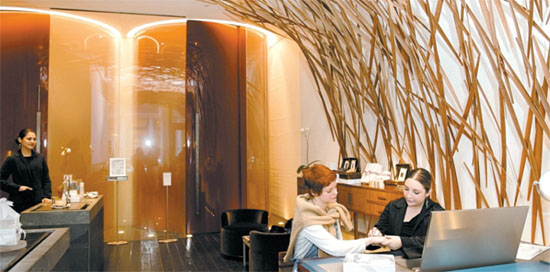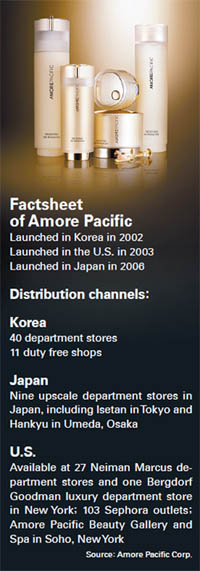Amore Pacific builds buzz overseas

A skin therapist, far right, checks the condition of a customer’s skin at Amore Pacific Beauty Gallery and Spa in New York’s Soho. The spa has seen a 60 percent increase in sales this year compared to 2010. Provided by the company
Amore Pacific’s move to claim an equal footing with foreign luxury cosmetic brands and expand its presence in overseas markets for high-end cosmetics is seeing healthy progress.
In 2002, CEO Suh Kyung-bae ambitiously rolled out the Korea-based company’s first global cosmetics brand, the eponymous Amore Pacific, with the aim of exporting local beauty expertise and Asian values to overseas markets, particularly the world’s two largest cosmetics market by value.
One year later, the brand opened its first flagship store in New York’s Soho, called Amore Pacific Beauty Gallery and Spa, with the express intention of tapping high-end customers. Industry sources say they can still recall the company’s daring spirit.
“Amore Pacific has been seeing sales increases of 45 percent on average every year since it entered the U.S. market,” said Lee Yoon-ah, a publicist at Amore Pacific.
“Our goal is to gradually expand our presence there.”
Currently, its branded products are available at the Bergdorf Goodman luxury department store in New York and 27 Neiman Marcus department stores throughout the country. The Amore Pacific range is also available at 103 Sephora stores in the U.S., according to the company.
Enhancing brand equity

In fact, in major department stores in the country, the Amore Pacific brand of cosmetics does not even rank among the top 10 best sellers.
“Other foreign high-end cosmetics that are on a similar level to Amore Pacific are La Mer, La Prairie and Sisley, as they also exclusively target high-end customers,” Lee said. “Most high-end cosmetics aren’t top 10 players in terms of department stores’ sales.”
Amore Pacific officials said the brand’s niche target means it was never destined to be a winner in terms of volume sales.
“The purpose of super luxury cosmetics is not to generate the highest level of profit or expand market share,” said Lee. “It’s about elevating the brand equity of the cosmetics maker. It is crucial to market a high-end brand differently because it creates a sense of prestige and credibility, and this has a positive effect on the company’s entire cosmetics portfolio.”
Industry sources said that marketing strategies for high-end cosmetics are distinct from tactics commonly used to market mass prestige, or “masstige,” cosmetics. For example, companies tend to eschew TV advertisements and door-to-door sales.
Long-term approach
However, the company conceded that once robust sales of high-end cosmetic brands in Japan are now experiencing sluggish growth compared to only a few years ago.
After entering into the Japanese market by opening an outlet at the Isetan Shinjuku department store in Tokyo in 2006, Amore Pacific products are now sold at nine upmarket department stores in the country.
“Japan, whose economy was already weak, was further hammered by the earthquake and tsunami experienced on March 11, and that naturally made customers turn to cheaper cosmetics brands,” said Lee, adding that Amore Pacific also suffered from this trend.
Meanwhile, CEO Suh stressed to his employees that he will continue to invest in the Japanese market.
Whether sales of high-end cosmetics brands rise or fall is not as important as keeping them running to boost the overall image of the company, which often requires adopting a long-term perspective, industry sources said.
“Many cosmetic brands enter advanced markets such as the U.S. and Japan mainly because they want to raise their profiles and make their brands more luxurious,” said one industry insider. “And while this takes time, just having a presence there raises the profile of the brand, which will at some point probably emerge as a new growth engine.”
By Kim Mi-ju [mijukim@joongang.co.kr]










with the Korea JoongAng Daily
To write comments, please log in to one of the accounts.
Standards Board Policy (0/250자)